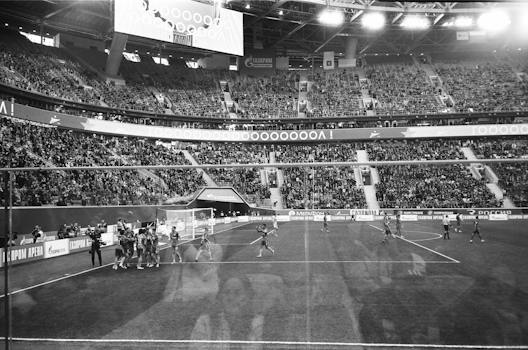

-
Table of Contents
"Unveiling the Hidden Signs: Mastering the Indicators of Conflict"
Introduction
Understanding the indicators of conflict is crucial in order to effectively manage and resolve conflicts. Conflict is a natural part of human interaction, and being able to identify the signs and indicators of conflict can help individuals and organizations address issues before they escalate. By recognizing these indicators, individuals can take proactive measures to prevent conflicts or intervene early on to minimize their negative impact. This article will explore some common indicators of conflict and provide insights into how to interpret and respond to them.
The Importance of Recognizing Early Warning Signs of Conflict
Understanding the Indicators of Conflict
Conflict is an inevitable part of human interaction. Whether it occurs in personal relationships, workplaces, or on a global scale, conflict can have significant consequences if left unaddressed. Recognizing the early warning signs of conflict is crucial in preventing its escalation and finding peaceful resolutions. In this article, we will explore the importance of recognizing these indicators and how they can help us navigate through challenging situations.
One of the primary reasons for understanding the indicators of conflict is to prevent its escalation. Conflict often starts with small disagreements or misunderstandings that, if not addressed promptly, can grow into more significant issues. By recognizing the early warning signs, we can intervene early on and prevent conflicts from spiraling out of control. This proactive approach can save relationships, prevent damage to organizations, and even avert larger-scale conflicts.
Recognizing the indicators of conflict is also essential for finding peaceful resolutions. When we can identify the signs of conflict, we can address the underlying issues before they become deeply entrenched. By doing so, we create an opportunity for open dialogue, understanding, and compromise. This approach fosters healthier relationships, promotes collaboration, and allows for the exploration of creative solutions.
So, what are some of the indicators of conflict that we should be aware of? One common sign is a breakdown in communication. When people stop listening to each other, misunderstandings arise, and tensions build. Another indicator is a change in behavior. People involved in a conflict may become more defensive, aggressive, or withdrawn. These behavioral changes can be subtle or overt, but they often signal underlying conflict.
Another indicator to watch out for is a lack of trust. When trust erodes, suspicion and skepticism take its place, making it difficult to work together effectively. Additionally, a power struggle can indicate the presence of conflict. When individuals or groups vie for control or dominance, conflicts can arise as a result of differing interests and goals.
It is important to note that conflict indicators can vary depending on the context. In personal relationships, indicators may include increased arguments, avoidance, or a decline in intimacy. In the workplace, indicators may manifest as decreased productivity, increased absenteeism, or a rise in employee grievances. Understanding the specific indicators within a given context is crucial for effective conflict management.
Recognizing the indicators of conflict is only the first step. Once we identify these signs, we must take appropriate action to address the underlying issues. This may involve initiating open and honest conversations, seeking mediation or professional help, or implementing conflict resolution strategies. The key is to approach conflict with a willingness to listen, understand, and find common ground.
In conclusion, understanding the indicators of conflict is vital for preventing its escalation and finding peaceful resolutions. By recognizing the early warning signs, we can intervene early on and address the underlying issues. This proactive approach can save relationships, prevent damage to organizations, and even avert larger-scale conflicts. By being aware of the indicators of conflict and taking appropriate action, we can navigate through challenging situations with greater ease and foster healthier relationships.
Understanding Nonverbal Cues and Body Language in Conflict Situations

Understanding the Indicators of Conflict
Conflict is an inevitable part of human interaction. Whether it occurs in personal relationships, professional settings, or even within ourselves, conflict can be both challenging and disruptive. In order to effectively manage and resolve conflicts, it is crucial to understand the indicators that signal the presence of conflict. One important aspect to consider is nonverbal cues and body language in conflict situations.
Nonverbal cues and body language play a significant role in communication, often conveying messages that words alone cannot express. In conflict situations, these cues become even more pronounced, as individuals may be hesitant or unwilling to openly express their feelings or concerns. By paying attention to nonverbal cues, we can gain valuable insights into the underlying emotions and tensions that contribute to conflict.
One common nonverbal cue in conflict situations is facial expressions. The face is a powerful tool for conveying emotions, and in times of conflict, it can reveal a range of feelings such as anger, frustration, or sadness. Furrowed brows, clenched jaws, or narrowed eyes are all indicators of potential conflict. Similarly, a forced smile or a lack of eye contact can suggest discomfort or unease.
Another important nonverbal cue to consider is body posture. In conflict situations, individuals may adopt defensive or closed-off postures as a means of self-protection. Crossing arms, leaning away, or turning away from the other person are all signs of resistance or disengagement. On the other hand, an aggressive posture, such as standing tall with a rigid stance, can indicate a readiness for confrontation.
Gestures also play a significant role in nonverbal communication during conflicts. Individuals may use gestures to emphasize their points or to express frustration. Pointing fingers, waving hands, or pounding fists on the table are all gestures that can escalate tensions and indicate a potential conflict. Conversely, individuals may also use gestures to signal a desire for resolution, such as extending a hand for a handshake or nodding in agreement.
In addition to nonverbal cues, it is important to consider the tone of voice in conflict situations. The way individuals speak can reveal their emotions and intentions. A raised or harsh tone of voice can indicate anger or aggression, while a soft or hesitant tone may suggest fear or uncertainty. By paying attention to these vocal cues, we can better understand the underlying emotions driving the conflict.
Understanding nonverbal cues and body language in conflict situations is essential for effective conflict resolution. By recognizing these indicators, we can address the root causes of conflict and work towards finding mutually beneficial solutions. However, it is important to note that nonverbal cues should not be interpreted in isolation. They should be considered in conjunction with verbal communication and the overall context of the situation.
In conclusion, nonverbal cues and body language provide valuable insights into the indicators of conflict. Facial expressions, body posture, gestures, and tone of voice all contribute to our understanding of the underlying emotions and tensions in conflict situations. By paying attention to these cues, we can navigate conflicts more effectively and work towards resolution.
Exploring the Role of Communication Styles in Conflict Resolution
Understanding the Indicators of Conflict
Conflict is an inevitable part of human interaction. Whether it occurs in personal relationships, professional settings, or even within oneself, conflict can have a significant impact on our lives. In order to effectively manage and resolve conflicts, it is crucial to understand the indicators that signal the presence of conflict. One important aspect to consider is the role of communication styles in conflict resolution.
Communication styles play a vital role in how conflicts arise and are resolved. Different individuals have different ways of expressing themselves, and these differences can often lead to misunderstandings and disagreements. Understanding the various communication styles can help us navigate conflicts more effectively.
One common communication style is passive communication. People who adopt this style tend to avoid confrontation and express their needs and opinions in a timid and non-assertive manner. They may feel uncomfortable expressing their true feelings and often prioritize maintaining harmony over addressing conflicts. Passive communication can be detrimental in conflict resolution as it may lead to unresolved issues and resentment.
On the other end of the spectrum, we have aggressive communication. Individuals who adopt this style tend to be forceful, dominating, and confrontational in their communication. They often prioritize their own needs and opinions over others and may resort to intimidation and personal attacks to get their point across. Aggressive communication can escalate conflicts and create a hostile environment, making resolution difficult.
Another communication style is passive-aggressive communication. People who adopt this style may appear passive on the surface but express their anger and frustration indirectly. They may use sarcasm, subtle insults, or backhanded compliments to convey their true feelings. Passive-aggressive communication can be confusing and frustrating for others, as it often involves hidden messages and mixed signals.
Lastly, we have assertive communication, which is considered the most effective communication style in conflict resolution. Individuals who adopt this style express their needs, opinions, and feelings in a direct and respectful manner. They are able to assert themselves without being aggressive or disrespectful towards others. Assertive communication promotes open dialogue, active listening, and collaboration, which are essential for resolving conflicts.
Understanding the different communication styles can help us identify the indicators of conflict. For example, if someone consistently avoids expressing their needs or opinions, it may indicate a conflict that needs to be addressed. Similarly, if someone frequently resorts to aggressive or passive-aggressive communication, it may signal underlying conflicts that require resolution.
In conflict resolution, it is important to recognize that communication styles can vary depending on the situation and the individuals involved. People may exhibit different communication styles in different contexts, and conflicts may arise due to a clash of styles. By being aware of these differences and adapting our communication approach accordingly, we can foster a more constructive and collaborative environment for conflict resolution.
In conclusion, understanding the indicators of conflict is crucial for effective conflict resolution. Communication styles play a significant role in how conflicts arise and are resolved. By recognizing the various communication styles, such as passive, aggressive, passive-aggressive, and assertive, we can better navigate conflicts and work towards resolution. Adopting an assertive communication style promotes open dialogue and collaboration, which are essential for resolving conflicts in a constructive manner.
Q&A
1. What are some common indicators of conflict?
- Increased tension and hostility between individuals or groups
- Frequent arguments or disagreements
- Lack of communication or breakdown in communication channels
- Increased absenteeism or decreased productivity
- Formation of cliques or factions within a larger group
2. How can body language indicate conflict?
- Aggressive or defensive postures, such as crossed arms or clenched fists
- Avoiding eye contact or turning away from the person involved in the conflict
- Facial expressions of anger, frustration, or contempt
- Restlessness or fidgeting
- Raised voice or aggressive tone of speech
3. What role does communication play in conflict?
- Poor communication or miscommunication can lead to misunderstandings and escalate conflicts.
- Lack of effective communication can prevent parties from expressing their needs, concerns, or perspectives.
- Open and honest communication can help identify and address underlying issues, leading to resolution and reconciliation.
- Active listening and empathy can foster understanding and reduce tensions in conflict situations.
- Effective communication skills, such as assertiveness and conflict resolution techniques, can help manage and resolve conflicts.
Conclusion
Understanding the indicators of conflict is crucial in effectively managing and resolving conflicts. By recognizing and interpreting these indicators, individuals and organizations can take proactive measures to prevent conflicts from escalating and causing further damage. Indicators such as increased tension, communication breakdown, and negative emotions can serve as warning signs, prompting the need for intervention and conflict resolution strategies. By addressing conflicts early on and promoting open dialogue, individuals and organizations can foster healthier relationships and create a more harmonious environment.












